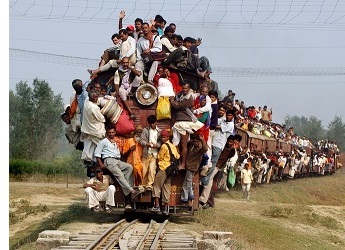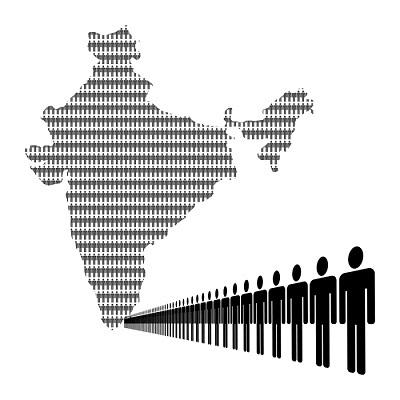

 India is the second most populated country in the world after China having 17% of the world’s population. It is diverse in terms of its population structure and culture having both tribal and non-tribal populations. Its population follows various religions like Hinduism, Sikhism, Islam, etc.
India is the second most populated country in the world after China having 17% of the world’s population. It is diverse in terms of its population structure and culture having both tribal and non-tribal populations. Its population follows various religions like Hinduism, Sikhism, Islam, etc.
India is diverse in terms of language also because of its because of its diverse racial element and geographical isolation for long time.
Indian population is divided into various ethnic types by different anthropologists based on anthropometric measurements and geographical presence.
| Classification | Type | Distribution |
|---|---|---|
Risley’s Classification (1915) |
Dravidian | South India (Santhal, Todas, etc. |
| Indo-Aryans | Northern India (Rajputs, Khatri, Jats, etc.) | |
| Mongoloids | Himalayan, sub-Himalayan regions and North-East India (Kinnets of Kullu and Lahul-Spiti, Bhutias and Lepchass of Sikkim) | |
| Scytho Dravidian | Gujarat, Maharashtra region (Marathas) | |
| Aryo-Dravidian | Rajasthan, Uttar Pradesh and Bihar | |
| Mongolo-Dravidian | West Bengal and Odisha | |
| Turko-Iranian | Some parts of North-west India (Pathans) | |
Giufrida’s classification (1921) |
Negritos | Veddas and some south Indian forest area |
| Pre-Dravidian/ Australoid | Oraons, Veddaic Santhals, Mundas, etc. | |
| Dravidians | Tamil and Telugu-speaking population | |
| Tall dolichocephalics | Todas | |
| Dolichocephalic Aryans | Also called Homo dolichomorphus brachymorphus. | |
| Brachycephalics Leucoderms | Also called Homo Indo-Europeans brachymorphic | |
A.C. Haddon’s classification (1924) |
Himalayan Zone |
|
| Northern Zone (Hindustan) | Indo-Gangetic plains (Jats and Rajputs) | |
| Deccan |
|
|
B.S. Guha’s Classification (1931) |
Negrito | Pulayans (Cochin and Travancore), Kadars, Irular, and primitive tribes of Wynad, now moved to hills of South East Asia |
| Proto-Australoid | Pulayan women and Urali (Travancore), Baiga (Rewa), Chenchu Kurumba, Bhils and Kols of western and central India and Oraon, Munda of Chotanagpur region | |
| Mediterranean (Dravidian) |
|
|
| Western Brachycephals |
|
|
| Nordic | North-west (Punjab) | |
| Mongoloid |
|
|
Eickstedt’s classification (1934) |
Weddid |
|
| Melanid (Black Indians) |
|
|
| Indid |
|
|
| Palaeo Mongoloid | Palayan from Wynad | |
S.S. Sarkar’s classification (1954) |
Australoid | South India (Urali, Paniyan, Kadar etc.) |
| Indo-Aryan | Baltics of Hindukush Mountain | |
| Irano-Scythian | Eastern Bihar, Bengal, Assam extended to Maharashtra, Gujarat and then to Deccan, Mysore, etc. | |
| Mundari speaking people | River valleys and plateaus of central and eastern India, i.e., Madhya Pradesh Chota Nagpur, and Orissa hills | |
| Far Eastern | Coast of Chittagong hill tracts (Malayan racial strain) | |
| Mongolian | Foothills of Himalayas and North eastern borders of India |
There are more than 200 languages spoken in Indian and 23 of them constitutes 97% of Indian Population. There are 22 languages in Eighth schedule of Indian Constitution. The Indian population has four major language families −
Austroasiatic/Austric − Spoken by 1.38% of total population which includes Central and Eastern India tribal belt like Santhals, Koraki, Munda, etc.
Dravidia − Spoken by South India comprising 20% population and includes Tamil, Telugu, Malayalam, Kannad and Gondi.
Indo-European (Aryan) − Spoken mainly in North, West, East and India comprising 73% of Indian population and includes Sindhi, Punjabi, Gujarati, Marathi, Rajasthani, Konkani, Bengali, etc
Tibeto-Burman/Sino-Tibetan − Spoken by North eastern population comprising 0.85% of Indian population and includes Ladakhi, Lepcha, Mishimi, etc.
Growth of population is the change in the number of people residing in a specific area over a time period. It has two components −

Natural growth − Studied by evaluating the birth and death rates. Birth rate is defined as number of live births per thousand people while death rate is defined as the number of deaths per thousand people.
Induced growth − Studied by the migration of people in any given area. It includes Emigration is number of people migrating out of country, Immigration is number of people migrating into a country and National migration is the number of people migrating within the country.
The decadal and annual growth rates of Indian population are very high and increasing steadily over time. The annual growth rate of Indian population is 1.64% as per 2011 census.
Demographic profile gives the statistical data of Indian population important for planning and implementating state policies for economic development and general public welfare. India is ethnically and linguistically a diverse country. Dravidians or Pre- Dravidians are considered as the original inhabitants of India. From major ethnic classifications, Guha’s classification is widely accepted for understanding the ethnic element in Indian population. Languages like Sanskrit is the link between some Aryan languages and Persian influences Tamil, Marathi, Bengali, etc. whereas Hindi-Urdu forms the linguistic unity of India. Indian population is influenced by physical, social, economical and cultural factors.
Q1. What is population density of India?
Ans. Population density can be explained as the number of people residing per square kilometer of land area. Currently, India’s population density is 464 people per sq. km.
Q2. What is natural growth rate?
Ans. Natural growth rate or natural population change is defined as the difference between birth rates and death rate of a country over a period of time.
Q3. List some factors influencing Indian Population distribution.
Ans. Population distribution is influenced by following factors
Geographical − Topography, water, soil, mineral and climate of a place influence people e.g. Gangetic plains
Social − Places with better health, education, housing and transportation facilities are more populated like Pune.
Cultural − Areas with cultural or religious importance attract people like Varanasi.
Economic − Area that provide more employment opportunities like Mumbai